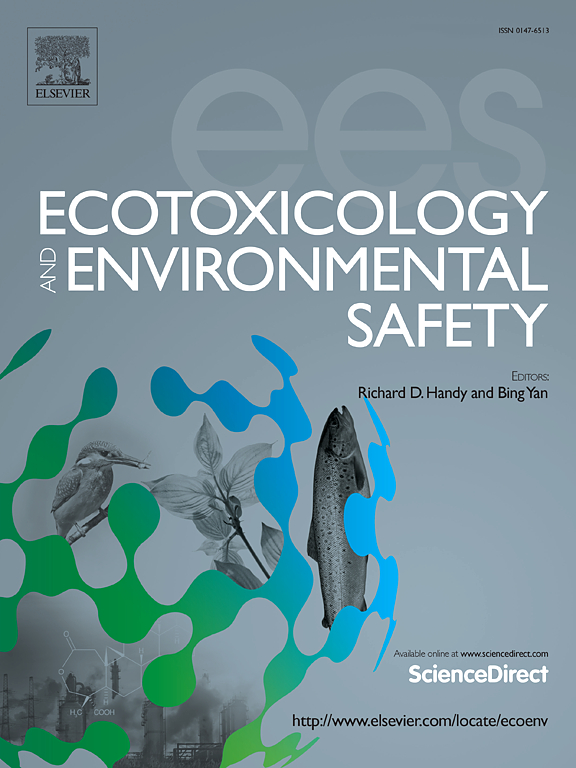玉米(Zea mays)和大豆(Glycine max)对纳米塑性诱导胁迫的综合生理、代谢组学和转录组学响应
IF 6.1
2区 环境科学与生态学
Q1 ENVIRONMENTAL SCIENCES
引用次数: 0
摘要
农用塑料的广泛使用和降解导致纳米塑料的积累和土壤污染,对农业生态系统构成越来越大的风险。本研究研究了玉米(Zea mays)和大豆(Glycine max)对粒径在20 ~ 50 nm范围内的聚乙烯纳米颗粒(PE-NPs)和聚丙烯纳米颗粒(PP-NPs)在土壤中浓度分别为50和500 mg/kg时的生理和分子响应差异。在45天的暴露期内,浓度为500 mg/kg时,两种NPs类型均显著抑制玉米和大豆的株高和新鲜生物量,其中PP-NPs对大豆的毒性大于玉米。当浓度为500 mg/kg时,两种作物的根系都积累了高水平的两种NPs,引发了氧化应激,丙二醛水平升高,过氧化氢酶活性显著下降,从而损害了根膜的完整性、抗氧化防御机制和养分利用率。但玉米光合效率高,根系生长旺盛,代谢分泌量大,对NPs胁迫的抗逆性优于大豆。为了比较玉米和大豆的分子反应,我们对暴露于500 mg/kg PP-NPs的植株进行了多组学分析。结果表明,这两种植物的嘌呤代谢和苯丙素的生物合成都受到了显著的破坏,其中大豆的影响更为明显。大豆表现出强烈的腺苷脱氨酶和腺苷酸激酶下调,黄嘌呤、肌苷和尿酸水平降低。在这两种植物中,苯丙氨酸解氨酶、反式肉桂酸4-单加氧酶和过氧化物酶等关键酶的表达都发生了显著变化,这表明苯丙氨酸生物合成及其下游类黄酮和木质素前体受到了重大影响。这些发现揭示了玉米和大豆对纳米塑料污染土壤恢复力的不同生理和多组学响应。本文章由计算机程序翻译,如有差异,请以英文原文为准。
Integrated physiological, metabolomic, and transcriptomic responses of maize (Zea mays) and soybean (Glycine max) to nanoplastic-induced stress
The widespread use and degradation of agricultural plastics lead to the accumulation of nanoplastics (NPs) and soil contamination, posing growing risks to agroecosystems. This study investigated the differential physiological and molecular responses of maize (Zea mays) and soybean (Glycine max) to polyethylene nanoparticles (PE-NPs) and polypropylene nanoparticles (PP-NPs), each within the size range of 20–50 nm, at concentrations of 50 and 500 mg/kg of soil. Over a 45-day exposure period, at 500 mg/kg concentration, both NPs types significantly suppressed plant height and fresh biomass in both maize and soybean, with PP-NPs demonstrating greater toxicity in soybean than in maize. At 500 mg/kg, both crops accumulated high levels of both NPs types in their roots, triggering oxidative stress as evidenced by elevated malondialdehyde levels and a significant decline in catalase activity, which compromised root membrane integrity, antioxidant defense mechanisms, and nutrient availability. However, maize's higher photosynthetic efficiency, more vigorous root growth, and greater metabolic exudation made it more resilient to the NPs stress than soybean. To compare the molecular responses of maize and soybean, we conducted a multi-omics analysis of plants exposed to 500 mg/kg PP-NPs. The results showed a significant disruption of purine metabolism and phenylpropanoid biosynthesis in both plants, with the effect more pronounced in soybean. Soybean exhibited strong downregulation of adenosine deaminase and adenylate kinase, with reduced levels of xanthine, inosine, and uric acid. Notable alterations in the expression of key enzymes, such as phenylalanine ammonia-lyase, trans-cinnamate 4-monooxygenase, and peroxidase in both plants indicate a substantial impact on phenylpropanoid biosynthesis and its downstream flavonoid and lignin precursors. These findings reveal the distinct physiological and multi-omics responses underlying the resilience of maize and soybean to nanoplastic-contaminated soils.
求助全文
通过发布文献求助,成功后即可免费获取论文全文。
去求助
来源期刊
CiteScore
12.10
自引率
5.90%
发文量
1234
审稿时长
88 days
期刊介绍:
Ecotoxicology and Environmental Safety is a multi-disciplinary journal that focuses on understanding the exposure and effects of environmental contamination on organisms including human health. The scope of the journal covers three main themes. The topics within these themes, indicated below, include (but are not limited to) the following: Ecotoxicology、Environmental Chemistry、Environmental Safety etc.

 求助内容:
求助内容: 应助结果提醒方式:
应助结果提醒方式:


